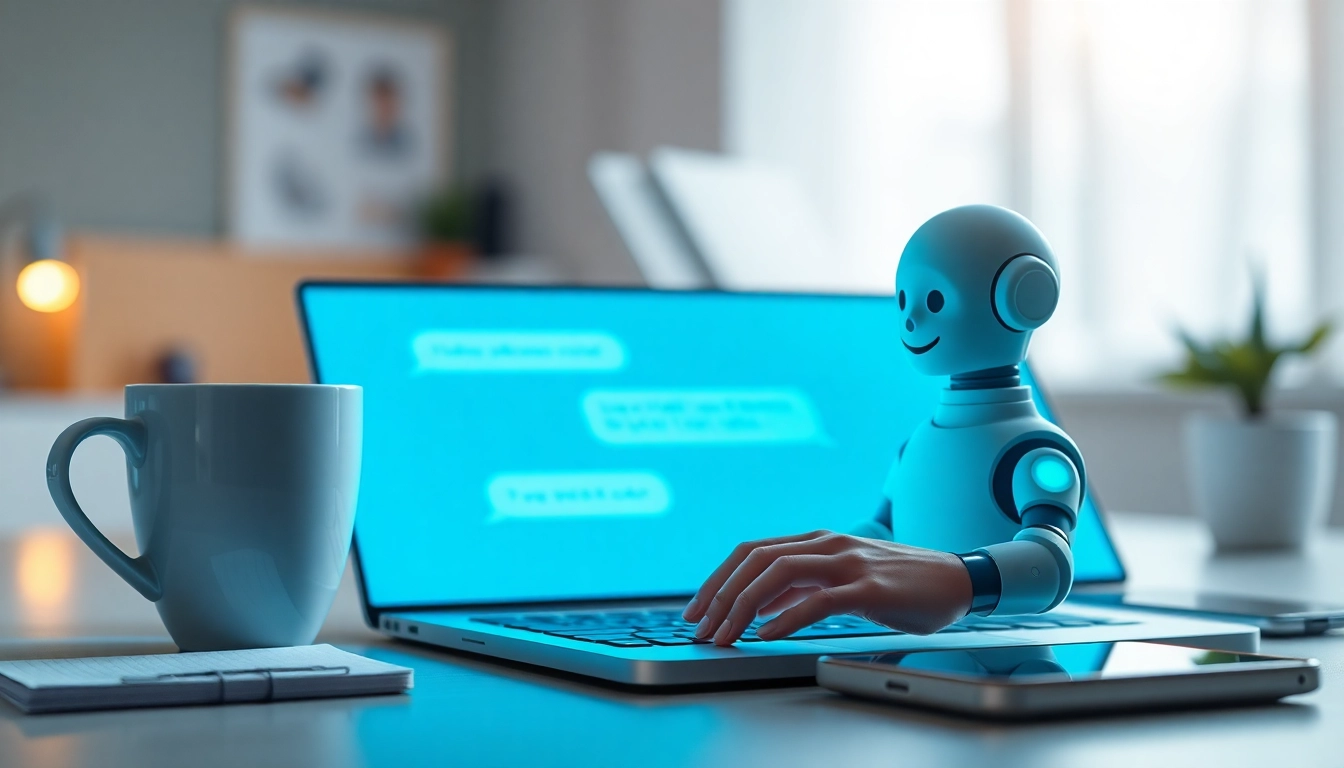Understanding the Basics of ChatGPT Bots
What is a ChatGPT Bot?
A ChatGPT bot is a sophisticated conversational agent powered by OpenAI’s GPT-3 (and its successors) natural language processing (NLP) technology. Unlike traditional chatbots that rely heavily on predefined responses and rigid frameworks, ChatGPT bots harness the power of deep learning to generate human-like text based on the input they receive. This model allows for dynamic interactions, making it possible for users to engage in free-flowing conversations that feel natural and contextually aware.
How ChatGPT Bots Work
At its core, a ChatGPT bot operates by predicting the next word in a sequence, which allows it to generate coherent and contextually appropriate responses. When a user inputs a query, the bot analyzes the text, understands the intent, and formulates a reply that is coherent and relevant. This process involves several steps:
- Input Processing: The model tokenizes the user input into digestible pieces of information.
- Context Understanding: Using historical interactions and conversation context, the bot generates an informed response.
- Response Generation: The model generates a response by considering syntax, semantics, and the nuances of human language.
This advanced understanding of language enables ChatGPT bots to handle complex queries and provide solutions in real-time, making them suitable for diverse applications like customer support, e-commerce guidance, and more.
Common Misconceptions About ChatGPT Bots
Many people hold misconceptions about ChatGPT bots, often viewing them as simple tools or gimmicks lacking real capabilities. Here are a few common myths debunked:
- “They can only answer simple questions.” While ChatGPT bots are effective at basic inquiries, they can also handle intricate and multi-layered queries thanks to their understanding of context.
- “They don’t learn or improve over time.” ChatGPT bots can be fine-tuned based on user interactions, allowing them to learn from past exchanges and enhance their performance continually.
- “They are just programmed to repeat information.” Unlike traditional chatbots, ChatGPT bots create unique responses using contextual understanding rather than merely regurgitating stored data.
These misconceptions can lead to undervaluation of ChatGPT bots in the business landscape. In reality, they offer robust capabilities that can significantly enhance user interactions on websites.
Benefits of Integrating a ChatGPT Bot for Your Website
Improving Customer Engagement
By integrating a ChatGPT bot into your website, you can create a more interactive environment for visitors. Unlike static content, a chatbot engages users by providing real-time responses, encouraging deeper exploration of your offerings. According to a report by HubSpot, 64% of consumers find 24/7 service to be the best feature of chatbots. This immediacy in communication fosters better engagement rates and helps build a rapport with your audience.
24/7 Support Capabilities
One of the standout features of ChatGPT bots is their ability to provide round-the-clock support. Businesses often struggle to manage customer inquiries outside of regular business hours, resulting in lost sales and diminished customer satisfaction. A ChatGPT bot can solve this problem by being available 24/7, addressing common queries, troubleshooting problems, and allowing customers to find information without delay. This constant availability not only enhances user satisfaction but can also lead to higher conversion rates as customers feel supported.
Cost Efficiency for Businesses
Employing a ChatGPT bot can significantly lower operational costs. Traditional customer service models often require extensive human resources, and deploying chatbots reduces the need for large support teams while still maintaining a high level of service quality. According to a report by Juniper Research, chatbots are expected to save businesses over $8 billion annually by 2022 in customer service costs. Not only do ChatGPT bots handle routine queries efficiently, but they also free up human agents to tackle more complex issues, improving overall productivity.
Implementation Steps for Your ChatGPT Bot
Selecting the Right Platform
Choosing the correct platform for your ChatGPT bot is crucial for effective integration with your website. Various platforms may offer unique features, including ease of use, customization capabilities, and integration options with existing software. Popular platforms such as chatgpt bot for website, Google Dialogflow, and Microsoft Bot Framework provide comprehensive tools tailored to different business needs. Consider factors like developer support, user interface, and pricing when making your decision.
Customizing Your ChatGPT Bot
Once you have chosen a platform, the next step is to customize your bot to reflect your brand’s voice and personality. This can include setting up predefined responses for frequently asked questions, designing the bot’s conversation flow, and implementing unique style elements that resonate with your target audience. It’s essential to create a bot that feels personal to your users. According to research, bots that use conversational language and tailored messages can increase user satisfaction by up to 35%.
Testing and Launching Your Bot
Before launching your ChatGPT bot, thorough testing is imperative. This involves simulating various user interactions to ensure the bot performs well across scenarios. Focus on evaluating its understanding of context, accuracy of responses, and overall engagement level. You could conduct A/B testing with different versions of the bot to gauge which one yields better results. Once testing is complete and adjustments have been made, launch your bot to the public and monitor its performance closely, ready to make iterative improvements as needed.
Best Practices for Using Your ChatGPT Bot Effectively
Enhancing User Experience with Custom Responses
To ensure a positive experience for users, it is vital to enhance your ChatGPT bot with custom responses. Personalization is key; utilizing user data, previous interactions, and contextual clues can help tailor responses in real-time. Rather than relying solely on generic answers, training your bot to respond with empathy and relevance can lead to greater user satisfaction. Studies show that personalized interactions drive loyalty, as users feel more connected to a brand that recognizes their individual needs.
Monitoring Performance Metrics
Post-launch, it’s important to continuously monitor your ChatGPT bot’s performance. Key performance indicators (KPIs) to track include response accuracy, user retention rates, session duration, and conversion rates. By analyzing these metrics, businesses can pinpoint areas for improvement. Google Analytics and user feedback can provide invaluable insights into how users interact with the bot, allowing you to make data-driven adjustments based on actual usage patterns.
Updating and Maintaining Your ChatGPT Bot
An effective ChatGPT bot requires ongoing maintenance and updates. Regularly updating the bot’s knowledge base with new information, refining responses based on user feedback, and keeping up with advancements in technology are essential for maintaining relevance. As consumer behavior and industry trends change, so too should your bot’s capabilities and knowledge set. Schedule routine checks to ensure that your bot remains an effective tool for customer engagement and service.
Future Trends in ChatGPT Bots for Websites
Advancements in Natural Language Processing
The field of natural language processing (NLP) is rapidly evolving, and the implications for ChatGPT bots are significant. Upcoming advancements promise even more nuanced understanding and generation capabilities. Future models may be able to process emotional undertones in user queries, allowing for more empathetic responses. Enhanced versatility in language understanding could also enable more diversified communication styles, catering to different demographic groups more effectively.
Personalization Features
As personalization becomes increasingly paramount in consumer interactions, ChatGPT bots will likely incorporate advanced personalization features. These features may include adaptive learning mechanisms that allow bots to tailor their conversations based on individual user preferences, previous interactions, and behaviors. This tailored approach can significantly enhance user satisfaction and drive conversions, as customers feel more recognized and catered to.
Integration with Other Technologies
Future ChatGPT bots will likely see deeper integration with other technologies, such as voice recognition systems, augmented reality (AR), and artificial intelligence (AI) tools. This interoperability will enhance usability and user experience, enabling more interactive and engaging interactions. For instance, a ChatGPT bot that integrates with AR could provide users with visual guides or simulations, making it a powerful tool across various sectors, such as retail and education.



